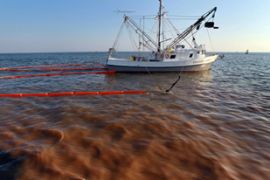Oil sheen washes up on US islands
As oil makes landfall, BP attempts to lower 100-tonne box to contain leaking well.

| IN DEPTH | |
|
“This is the first confirmation of shoreline impact we have had,” Curry said.
“We are doing everything we can to make sure a major impact doesn’t happen.”
The Chandeleur Islands form the easternmost point of Louisiana and are part of the Breton National Wildlife Refuge – the second oldest refuge in the US and home to countless endangered shorebirds.
Containment box
BP, meanwhile, has been working to deploy a 100-tonne concrete-and-steel box to the source of the massive oil leak, 1,500m underwater.
Around 800,000 litres of oil are spewing from the blown-out well daily into the Gulf of Mexico.
| Race to stop oil flow |
|
Engineers struggling to find a way to halt the flow of oil from the damaged well are working along three paths:
|
The British energy giant, which owns the leaking well, hoped to have the containment device down on the seabed by Thursday evening, but did not expect it to be fully operation until at least Sunday or Monday.
While similar devices have been used in the past, they have never been tested at this depth, and it was not clear whether it would still function properly.
If it does work, the system could collect as much as 85 per cent of the oil that’s been leaking from the ocean floor after the Deepwater Horizon rig exploded on April 20, killing 11 workers.
In addition to the ship carrying the box, another BP-chartered boat will use a crane to lower it – something that has never been tried before at such depths.
“We’re even more anxious,” Douglas Peake, first mate on the ship lowering the box, said.
“Hopefully, it will work better than they expect.”
The box is not expected to solve the problem altogether, and crews are drilling a relief well to take the pressure off the blown-out well at the site, but that could take up to three months to complete.
Marine disaster
Al Jazeera’s Cath Turner, reporting from the Gulf of Mexico, said that water off the Mississippi coastline was now pinkish-reddish in colour, having been stained by oil and dispersant.
“The mostly fine weather has helped authorities contain the spill, but there’s no telling how long that will last,” Turner said.
She said that she had seen casualties of the oil – a bird that had been drifting in the slick for some time and was so weak that it could barely move.
“Its feathers were slippery with oil sheen … it didn’t have long to live.”
Experts said that as oil began washing up along the coast, globules of oil were already falling to the bottom of the sea, where they threaten virtually every link in the ocean food chain, from plankton to fish.
Continuing efforts
Oil had been leaking in three places since the explosion, but BP announced on Wednesday that one small leak had been capped.
| Video: What caused the slick |
|
Al Jazeera looks at what engineers are facing in trying to stem the flow of oil |
The rest of the oil is coming from the blowout preventer at the well, a heavy piece of machinery designed to prevent blowouts that failed in the April 20 explosion, and crews have failed to shut it off using robotic devices.
If the box being lowered Thursday is successful in containing the bigger leak, a second box being built may be used to stop the second, smaller leak at the blowout preventer.
“This has never been done before. Typically you would put odds on something that has been done before,” Bob Fryar, a senior executive vice president for BP’s Deep Water Angola, said.
The containment box has a dome-like structure at the top that’s designed to act like a funnel and siphon the oil up through 1,500 meters of pipe and onto a tanker at the surface.
Crews need to properly position the four-storey structure with the help of a remote-controlled robotic submarine before a steel pipe can be attached to a tanker at the surface and connected to the top of the dome to move the oil.
That process presents several challenges because of the frigid water temperature and the volatile cocktail of oil, gas and water, though engineers think they have devised methods to deal with both issues safely.

 Breaking up oil
Breaking up oil